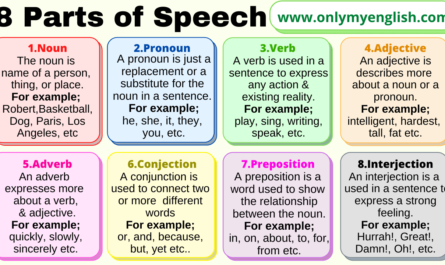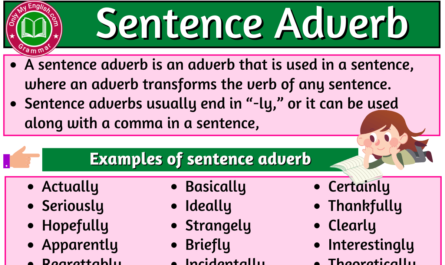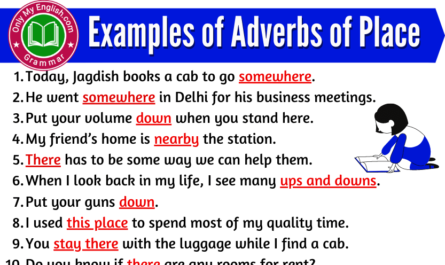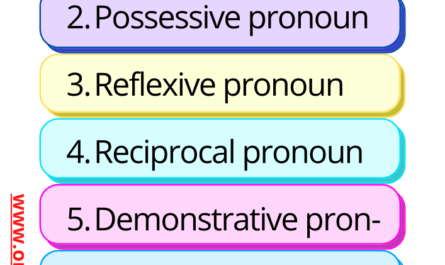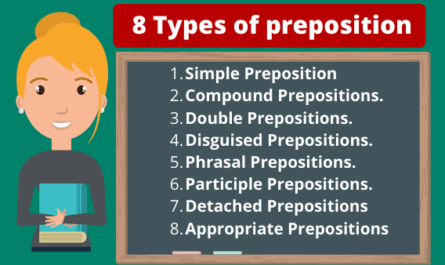What is an Adverb?
An Adverb is one of the parts of speech that expresses to transform or to modify other types of words like another adverb, adjective, clause, verb, or any other word or phrase, clause, preposition, determiner, etc. except certain adjectives that qualify straight nouns.
Mostly, adverbs end with a suffix -ly respectively.
Rules of formation of Adverbs:
- To form an adverb from adjectives, simply add “-ly” at the end:
For example,
- Beautiful-beautifully, Quiet-quietly, extreme-extremely, careful-carefully, etc.
2. To form an adverb from such words with “-le”, change it to “-ly”:
For example,
- Miserable- miserably, probable-probably, possible-possibly, probable-probably, etc.
3. To form an adverb from such words or adjectives that ends with “-y”, change it to “-ly”:
For example,
- Angry-angrily, lucky-luckily, happy-happily, etc.
4. Forming an adverb from a word that ends with “-ic”, change it to “-ically”:
For example,
- Scientific-scientifically, basic-basically, classic-classically, ironic-ironically, etc.
5. Conversion of some adjectives to adverbs which is irregular:
For example,
- Fast-fast, hard-hard, good-well, etc.
Adverbs are used to describe whether something has happened like how, how often, when, where, etc.
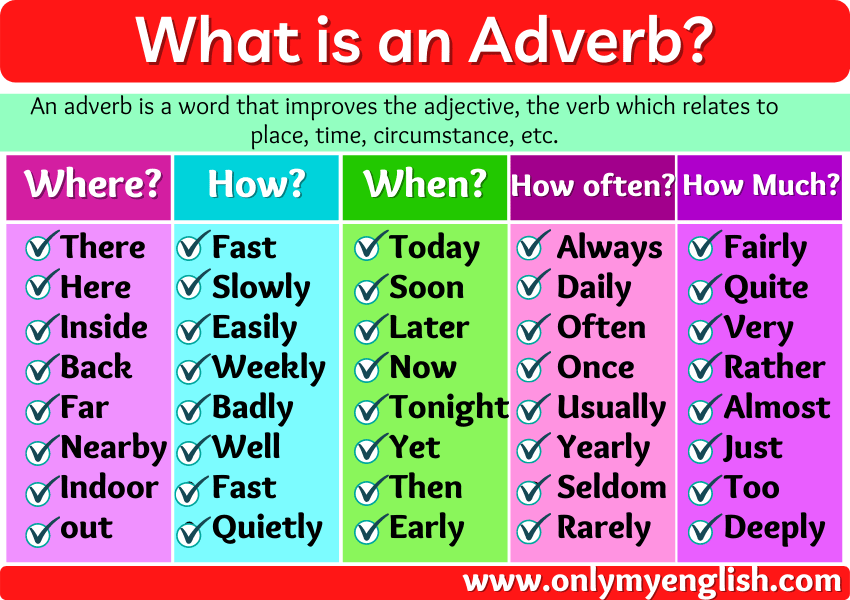
Types of Adverbs:
Depending on the place, timing, and frequency of the adverbs in any sentence, Adverbs are classified into five different types,
- Adverbs of time
- Adverbs of place
- Adverbs of manner
- Adverbs of degree and
- Adverbs of frequency.
Adverbs of time:
The adverbs of time give some more details about the timing of the verb that tells what happens which is used in a sentence. It normally comes in a sentence either at the beginning of the sentence supported with a comma or at the end by the importance it is used to express about the moment.
The function of the Adverbs of time is similar to that of the adverbs of frequency.
- Already, now, ago, yesterday, tomorrow, next week, last week, Sometimes, always, during, soon, yet, usually, just, recently, before, constantly, eventually, frequently, daily, immediately, hourly, weekly, monthly, yearly, etc. are adverbs of time.
Examples:
- She forgot to bring her lunch box yesterday and now also.
- We went to the annual gathering ceremony last year this month.
- The meeting has been postponed to the next week.
- He recently purchased a costly Diamond necklace.
- He was caught sleeping during the history lecture.
Adverbs of place:
The adverb of place is a type of adverb that is used to express the place of the verb which is used in a sentence to tell whether the action happens.
These adverbs are also called spatial adverbs and are placed after the main verb; also, they can appear at the end of the sentence with an object.
Adverbs of place also provide direction, position, and distance along with place.
These adverbs do not usually end with “-ly”.
These adverbs are a bit confusing along with a prepositional phrase because prepositional phrases tell where something is located or placed, but the adverb tells where something occurs, or happens.
- Everywhere, nowhere, anywhere, here, there, above, below, inside, outside, into, etc. are adverbs of place.
Examples:
- We had founded her everywhere, but she is not present.
- The dead bodies are split and smashed here and there when they reach the blast location.
- Your car has blocked the entire road outside the mall.
- He jumped into the river to save that boy.
- Your birthday present is placed inside the box.
Adverb provides direction:
- The parachute is going down the earth.
- Amsterdam is located in western Europe.
Adverb provides distance:
- That mountain is far away than it looks by our naked eyes.
- She is sitting next to me on the bus.
Adverb provides position:
- You are sitting on my phone.
- Pull this vehicle forward with the help of a towing van.
Adverbs of manner:
An adverb of manner is an adverb that shows some behavior, action, and manner.
Mostly, these adverbs are present at the end of the sentence or sometimes placed before or after the verb.
It modifies other adverbs in a sentence and gives more details of a noun and ends with -ly.
- Dangerously, softly, quickly, gently, beautifully, neatly, calmly, slowly, sadly, loudly, kindly, politely, fast, carefully, carelessly, effortlessly, urgently, rapidly, etc. are adverbs of manner.
Examples:
- She passed between the fencing easily.
- He is handling utensils very carefully.
- She ran very quickly into the room after looking at her teacher, coming to her home.
- He sorted out the entire situation politely.
- The entire function is ruined badly because of the power cut.
Adverbs of Degree:
An adverb of degree describes the details of any operation that is happening in a sentence and its situation and shows the strength of an adjective.
It is placed at the end of the sentence.
- Entirely, slightly, highly, totally, almost, just, nearly, hardly, too, etc. are adverbs of degree.
Examples:
- That portion is slightly down than this one.
- Petrol is a highly inflammable fuel.
- Her project work is almost finished.
- It took hardly 45 minutes for me to reach there by bike.
- The interior of the car was totally burnt.
Adverbs of Frequency:
An adverb of frequency is the adverb that explains how frequently something happened in spite of time specification. These adverbs come before the main verb in a sentence.
Adverbs of frequency are relatively the same as the adverbs of time.
- Constantly, occasionally, periodically, almost always, usually, often, sometimes, seldom, almost never, regularly, always, never, frequently, rarely, etc. are adverbs of frequency.
Examples,
- She behaves normally in front of the police officer after the incident like nothing happened.
- She waters the plants regularly in the evening.
- I seldom go to the gym for a workout.
- These ladies love to do shopping occasionally.
- The helping verb usually comes before the main verb.
